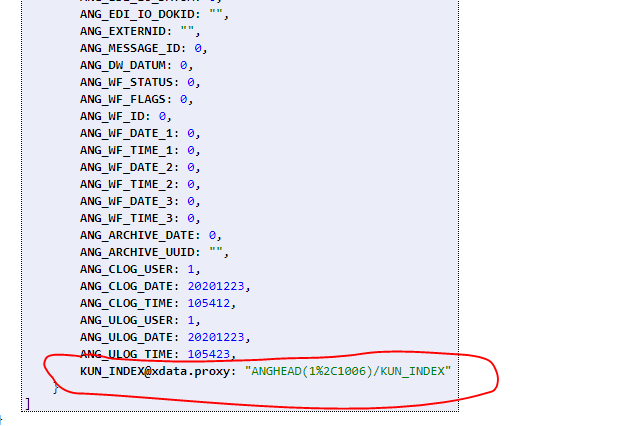Hello Wagner,
Further to my previous mail, here is the aspects of the code I have added. This may make it easier for you to assist.
THE ENTITY(s)
[Entity]
[Table('ANGHEAD')]
[Id('FANG_ORIGNR', TIdGenerator.None)]
[Id('FANG_ANR', TIdGenerator.None)]
TANGHEAD = class
private
[Column('ANG_ORIGNR', [TColumnProp.Required])]
FANG_ORIGNR: Integer;
[Column('ANG_ANR', [TColumnProp.Required])]
FANG_ANR: Integer;
[Column('ANG_EXECNR', [TColumnProp.Required])]
FANG_EXECNR: Integer;
[Column('ANG_VONNR', [TColumnProp.Required])]
FANG_VONNR: Integer;
[Column('ANG_KNR', [TColumnProp.Required])]
FANG_KNR: Integer;
[Association([TAssociationProp.Lazy], [])]
[JoinColumn('ANG_KNR', [], 'KUN_NUMMER')]
FKUN_NUMMER: Proxy;
function GetKUN_NUMMER: TKUNDE;
procedure SetKUN_NUMMER(const Value: TKUNDE);
public
property ANG_ORIGNR: Integer read FANG_ORIGNR write FANG_ORIGNR;
property ANG_ANR: Integer read FANG_ANR write FANG_ANR;
property ANG_EXECNR: Integer read FANG_EXECNR write FANG_EXECNR;
property ANG_VONNR: Integer read FANG_VONNR write FANG_VONNR;
property ANG_KNR: Integer read FANG_KNR write FANG_KNR;
property KUN_NUMMER: TKUNDE read GetKUN_NUMMER write SetKUN_NUMMER;
end;
[Entity]
[Table('KUNDE')]
[Id('FKUN_TYP', TIdGenerator.None)]
TKUNDE = class
private
[Column('KUN_INDEX', [TColumnProp.Required], 30)]
FKUN_INDEX: string;
[Column('KUN_FILIALE', [TColumnProp.Required])]
FKUN_FILIALE: Integer;
[Column('KUN_LAND', [TColumnProp.Required])]
FKUN_LAND: Integer;
[Column('KUN_REGION', [TColumnProp.Required])]
FKUN_REGION: Integer;
[Column('KUN_KONTO', [TColumnProp.Required])]
FKUN_KONTO: Integer;
[Association([TAssociationProp.Lazy, TAssociationProp.Required], CascadeTypeAll - [TCascadeType.Remove])]
[JoinColumn('KUN_TYP', [TColumnProp.Required], 'ADD_TYP')]
[JoinColumn('KUN_NUMMER', [TColumnProp.Required], 'ADD_NUMMER')]
FKUN_TYP: Proxy<TADR_DATA>;
function GetKUN_TYP: TADR_DATA;
procedure SetKUN_TYP(const Value: TADR_DATA);
property KUN_INDEX: string read FKUN_INDEX write FKUN_INDEX;
property KUN_FILIALE: Integer read FKUN_FILIALE write FKUN_FILIALE;
property KUN_LAND: Integer read FKUN_LAND write FKUN_LAND;
property KUN_REGION: Integer read FKUN_REGION write FKUN_REGION;
property KUN_KONTO: Integer read FKUN_KONTO write FKUN_KONTO;
end;
implementation
function TANGHEAD.GetKUN_INDEX : TKUNDE;
begin
result := FKUN_INDEX.Value;
end;
procedure TANGHEAD.SetKUN_INDEX(const Value: TKUNDE);
begin
FKUN_INDEX.Value := Value;
end;
THE SERVICE IMP
function TCOrderService.GetCorderlist: TObjectList;
var
Manager: TObjectManager;
begin
Result := TXDataOperationContext.Current.GetManager.Find
.Select(
TProjections.ProjectionList
.Add( Linq['ANG_ANR'].As_('Order_No') )
.Add( Linq['ANG_TEXT'].As_('Text') )
.Add( Linq['ANG_KLASSIFIZIERUNG'].As_('Classification') )
.Add( Linq['ANG_VONNR'].As_('Delivery_By') )
.Add( Linq['ANG_KNR'].As_('Customer_No') )
.Add( Linq['KUN_NUMMER'].As_('Customer_Name') )
)
.Where((Linq.Eq('ANG_ANR', 1006))
and (Linq.Eq('ANG_KNR', 2))
and (Linq.Eq('ANG_OK', 0))
and (Linq.Eq('ANG_KLASSIFIZIERUNG', '')))
.OrderBy('ANG_ANR')
.Listvalues;
end;
RESULT

Thank you for all your assistance.

